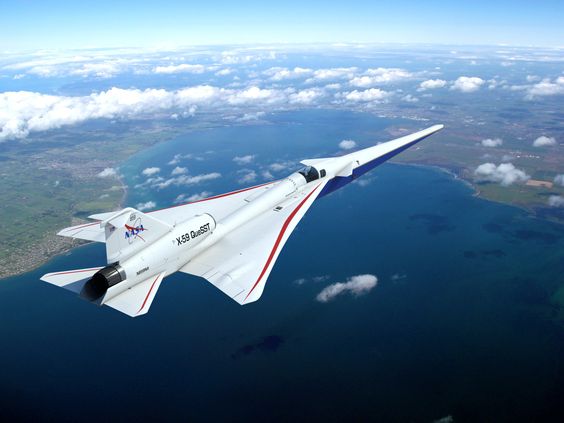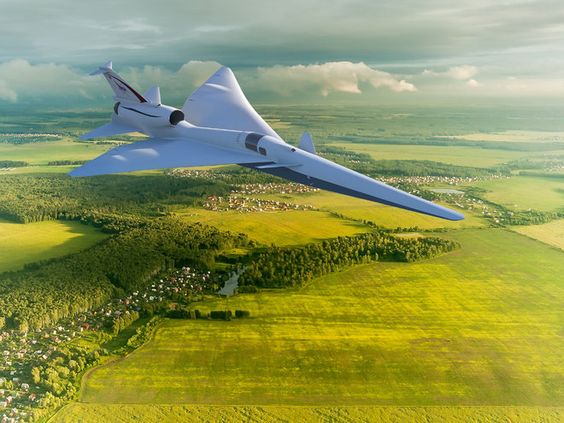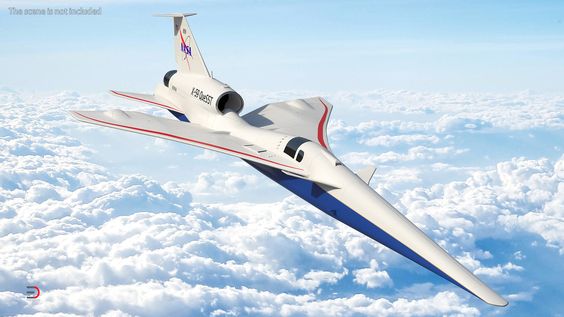NASA’s Stealth Supersonic X-Plane Reveals the Future of Sonic Travel
NASA’s silent supersonic X-plane is a shining example of innovation in the aviation industry, where technological advancements always push the envelope of what is possible. The launch, which was supposed to happen sooner, has been pushed back until 2024. This delay highlights the complex issues in creating a supersonic aircraft that travels faster than sound and does so without producing the annoying sonic boom associated with conventional supersonic flight. Let’s examine the complexities of NASA’s ambitious project, the reasons for this delay, and how the silent supersonic X-plane could revolutionize air travel in the future.
Origin of the Noiseless Supersonic X-Plane:

Since the beginning of aviation, there has been a persistent aspiration to achieve supersonic flight. The sonic boom, a shockwave created when an airplane exceeds the speed of sound, has, however, been a significant obstacle to making this ambition a reality. The disruptive effects of sonic booms on the ground frequently result in restrictions on traditional supersonic flying over land.
NASA launched the Quiet Supersonic Transport (QueSST) program in answer to this difficulty, to create a supersonic aircraft that emits a softer, more tolerable thump rather than a loud boom. The low-boom technology was intended to be tested and validated by the X-plane, given the official designation X-59 QueSST.
The Innovations in Technology:

Several state-of-the-art technologies are used by the X-59 QueSST to minimize sonic booms:
Form Is Important:
The architecture of the aircraft has been meticulously engineered to reduce the production of shockwaves. The meticulously sculpted surfaces and long, narrow design serve to lessen the severity of the sonic boom.
Creative Wing Architecture:
A distinctive wing design of the X-59 is called a forward-swept wing, and it helps lessen the force of shockwaves. This innovative design deviates from the typical airplane designs.
Obstacles and the Postponement:
The X-59’s maiden flight was delayed, which emphasizes how difficult it is to create and test such innovative technology. There are several reasons for the delay, including:
Technical Difficulties:
A low-intensity sonic thud can only be produced by a supersonic aircraft that overcomes several technological obstacles. To achieve the intended decrease in sonic boom, precision in design and construction is essential.
Safety Procedures:
Before any aircraft goes to the skies, it must undergo significant testing and validation to comply with the strict safety regulations connected with experimental flight testing. It is vital to make sure that everyone on the ground and onboard the aircraft is safe.
Unexpected Difficulties:
Aerospace projects with high aspirations frequently face unanticipated challenges that might affect schedules. One reason for the delay in the X-59’s maiden flight might be resolving unforeseen issues that came up during development.
What the Silent Supersonic X-plane Means:

The silent supersonic X-plane is a ground-breaking project with significant implications for the future of air transport, even with its delay:
Mitigation of Sonic Boom:
If the low-boom technology of the X-59 is tested successfully, it may eventually lead to the removal of limitations on supersonic flying over land. This would drastically cut down on journey times, revolutionizing commercial aviation travel.
Worldwide Effect:
The X-59’s technology might have an impact on international aviation regulations. Supersonic flight has attracted interest from nations all around the world, and NASA’s achievements may have an impact on how international air travel develops in the future.
Commercial Uses:
Even though the X-59 is a research vehicle, commercial supersonic aircraft may someday use some of its technologies. Both travelers and the aviation sector are very interested in the possibility of quicker and more effective air travel.
Environmental Factors to Be Considered
The legacy of the X-59 includes efforts to make supersonic flight more ecologically friendly. A crucial part of the development of the aircraft is striking a balance between the advantages of speedier travel and environmental concerns.
Public View and Acknowledgment:
How the general public interprets the aircraft’s milder thumps is one of the key questions NASA hopes to answer with the X-59 program. The future supersonic flight will be greatly influenced by public acceptability.
Outreach to the Community:
To enlighten locals on the purpose of the flights and to get input on noise levels, NASA has been actively involved in community engagement. By being proactive, we hope to allay worries and guarantee openness through the testing procedure.
Possibilities for Education:
In addition to providing educational opportunities, the X-59 program enables researchers to examine people’s responses to aircraft noise. Regulations and guidelines for future supersonic flight over populated areas will be shaped in large part by this data.
In conclusion, Navigating air travel in the future
Although unfortunate, the delay in the silent supersonic X-plane’s inaugural flight by NASA highlights the difficulties that come with leading the way in groundbreaking aerospace technological breakthroughs. The X-59 program’s eventual success will depend not only on low-boom technology’s technological advancements but also on the aircraft’s capacity to handle challenging environmental, regulatory, and public acceptability scenarios.
More than merely a test flight, the X-59’s ascent into the skies in 2024 signifies the quest for a day when supersonic travel is not only quicker but also more sensitive to the communities it passes through. A new era of air travel, where efficiency, speed, and environmental responsibility come together to create a global aviation landscape that pushes the bounds of what was previously thought to be impossible, is about to begin with the silent supersonic X-plane.








